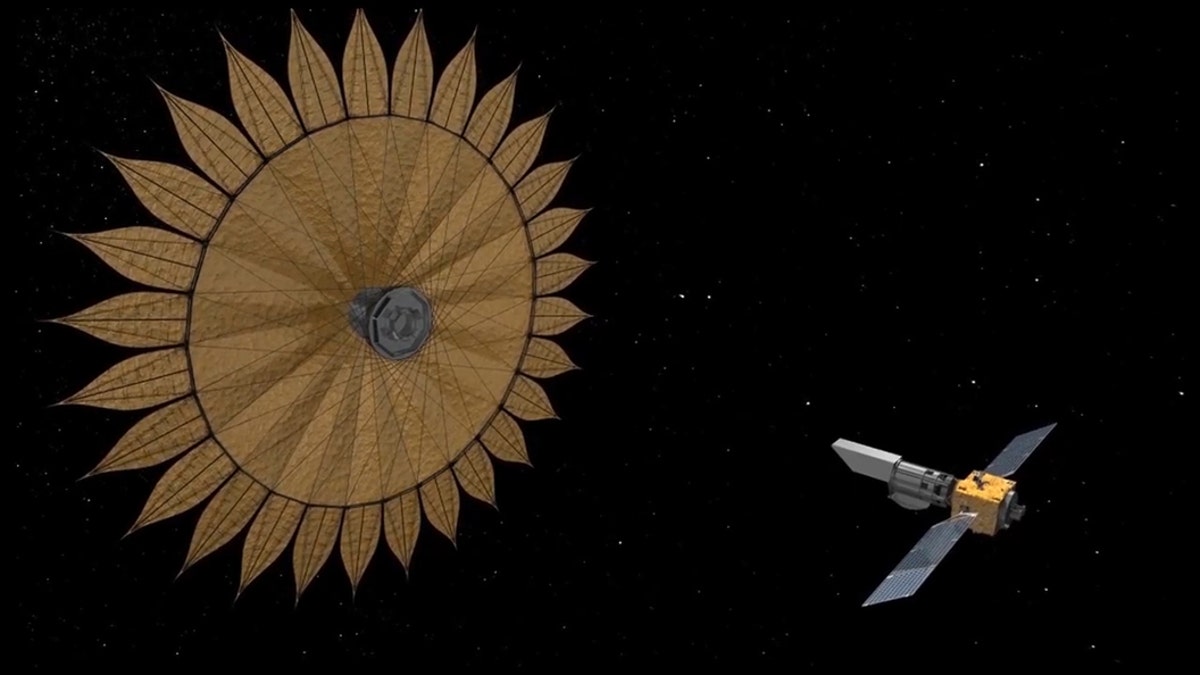Fox News Flash top headlines for June 18
Fox News Flash top headlines for June 18 are here. Check out what's clicking on Foxnews.com
NASA is upping the ante as it continues its search for alien planets and may wind up using a starshade in one of its upcoming missions.
The government space agency said that any potential mission would need a space telescope, as well as a starshade flying approximately 25,000 miles in front of it, packed with a petal-like shade to block out light from distant stars in hopes of finding "planets beyond our solar system, including pictures of planets as small as Earth."
"The distances we're talking about for the starshade technology are kind of hard to imagine," said JPL engineer Michael Bottom in a statement. "If the starshade were scaled down to the size of a drink coaster, the telescope would be the size of a pencil eraser and they'd be separated by about 60 miles [100 kilometers]."

This artist's concept shows the geometry of a space telescope aligned with a starshade, a technology used to block starlight in order to reveal the presence of planets orbiting that star. (Credit: NASA/JPL-Caltech)
NASA SET TO VISIT MYSTERIOUS DEAD METAL PLANET
Bottom continued: "Now imagine those two objects are free-floating in space. They're both experiencing these little tugs and nudges from gravity and other forces, and over that distance we're trying to keep them both precisely aligned to within about 2 millimeters."
He was able to build an algorithm to figure out whether the starshade and telescope could work in conjunction with one another; accounting for small leaks of light that will always occur, the results were encouraging.
"We can sense a change in the position of the starshade down to an inch, even over these huge distances," Bottom added.
Bottom's work was backed up by the work of fellow JPL engineers, including Thibault Flinois, who designed algorithms to determine when the starshade would need to fire the thrusters so that it could accurately align with the telescope and block out the light from the stars.
"This to me is a fine example of how space technology becomes ever more extraordinary by building upon its prior successes," said Phil Willems, manager of NASA's Starshade Technology Development activity in the statement. "We use formation flying in space every time a capsule docks at the International Space Station. But Michael and Thibault have gone far beyond that, and shown a way to maintain formation over scales larger than Earth itself."
The starshade and telescope would launch as one object, but after arriving in space, they would split off from each other. NASA JPL posted a video to its YouTube channel detailing how it would work.
Although there are no current plans to support a starshade mission, one could be on the horizon, especially in light of a working paper released by NASA earlier this year.
In January, a report on the feasibility of such a mission stated it could be done, provided certain parameters for the starshade and telescope are met and the distance between the two is vast.
NASA CHIEF SAYS RETURNING ASTRONAUTS TO THE MOON COULD COST $30 BILLION
"Overall, the ExoTAC [Exoplanet Exploration Program TAC] believes that Milestone #4 has been fully met and congratulates the entire team on their excellent efforts to advance the technology readiness levels of the elements in the S5 activity," the team wrote in the report. "Precision lateral control over thousands of kilometers is an unprecedented requirement, and essential for starshade operation. Achieving this first of fifteen S5 Milestones serves as a confidence builder for the entire S5 activity."





















